Written by Charlie Hulme
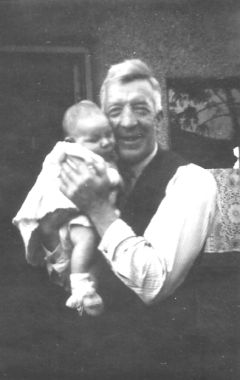
James Hill and the author, 1949.
My mother, Agnes Hulme, was the daughter of James Hill, whose early history is to be found in my article on his father George Hill who died in Stockport in 1916. This piece takes up the story, as much I have been able to piece it together from my memory of family stories and some guesswork. I you know any more, please get in touch.
James Hill was only one of my grandparents to survive into my lifetime. I didn't get to know him well, but I do remember one thing that he told me: 'Anyone can take a machine apart: if you can put it back together you are an engineer.'
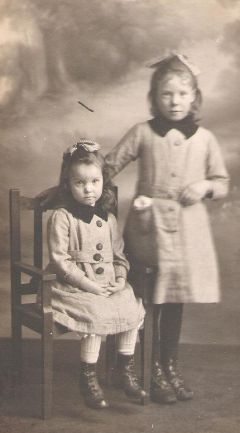
Ethel and Agnes Hill, c. 1923.

James and Edith Hill at 'Merlewood', c.1927.
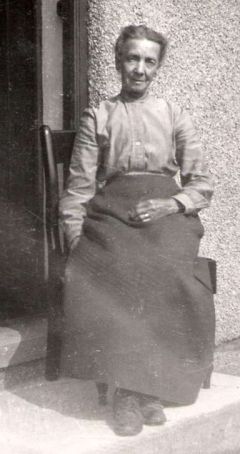
James's mother Alice at 'Merlewood', c1927.
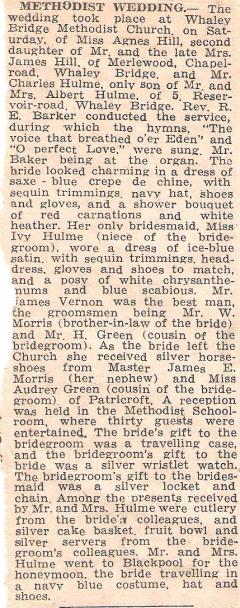
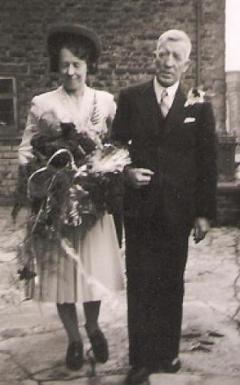
'Giving away' Agnes, 1948
The British Empire Exhibition, 1925
(Written by Agnes Hulme 60 years later)
Great excitement! We were going to London. I just qualified as we were going in August and you had to be thirteen and I had been thirteen on the 30th of June.
It was £25-00 for the fare and the hostel cost for a week, and you couldn't have more than £10 spending money. I did all sorts of jobs to get that £10, it was a lot of money in those days.
When we arrived, we were allocated a row of camp beds. The next row to use was a party of black children, and as we had never seen a black person before we went up to touch them to make sure it was real and not painted on.
Each country had its own pavilion and in the New Zealand one was a status of the Price of Wales on his horse, made of blocks of ice. The first thing we did every morning was to see if it had melted, as we didn't known anything about fridges then. If it was very warm the bottle of milk was put in a bottle of cold water to stop it going off.
Of all the things that we must have seen, the one thing that has remained in my mind ever since was the Prince of Wales on his horse.
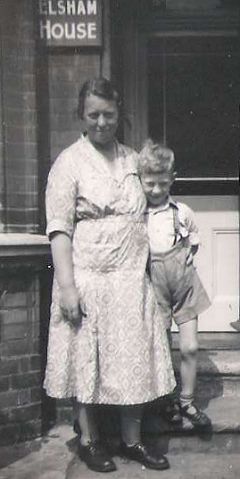
Agnes and myself on holiday at Great Yarmouth, 1955.
The Hollingdrake story

The firm of Hollingdrake was a long-established one. It was in 1814 that Henry Hollingdrake set up a small foundry in Underbank, Stockport, near the White Lion Hotel. By James Hill's time, the much-enlarged operation was in the hands of Henry's grandson Sir Henry Hollingdrake, J.P. and his brother Herbert. Their large factory in Princes Street had been much enlarged and updated in 1908, and no doubt they were in need of more skilled workers. There was also their foundry in Stewart Street, their mill furnishing business in Princes Street, and a new subsidiary, the Hollingdrake Motor Company, founded in 1902 and by 1922 described by the Stockport Advertiser as 'one of the best known and most enterprising motor concerns in England'. Their first car showroom and works was established in 1904 at 205 Wellington Road South for the assembly and sale of the imported French-made ‘La Buire’ vehicles which they imported in chassis form and built their own bodies. Buchet chassis, also French, were imported a few years later. By the time their showroom on Edward Street opposite the Town Hall was opened in 1923, the car company had become simply a sales operation for ready-made cars. In more recent years the 1923 building was used for the display of Lamborghini cars, eventually being demolished amid some controversy in 2016.
Modern life, 1920s style
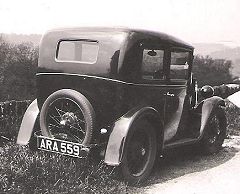
As a motor engineer, James Hill naturally wanted the latest technical developments, but he was never a wealthy man. After the motorcycle shown in the heading picture, by 1937 he was able to afford a car - the famous Austin Seven, ARA 559, known to the family as 'Daisy.'
'Merlewood' had some modern features too. Electric lighting, powered by a temperamental generator in the garden which Agnes had to attend to in all weathers, and a radio - in the form of a 'crystal set' which had to be listened to on headphones while sitting on the stairs, and depended for its signal - which also provided enough power to drive the headphones - on a wire aerial which was stretched on posts down the garden. The BBC had started radio broadcasts from a studio and transmitter in Trafford Park, Manchester, in 1922.
'Merlewood' in later days
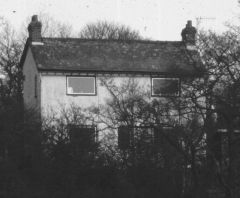
When James and Winifred left in 1953, 'Merlewood' was sold and eventually became the home of a business, 'Merlewood Kennels and Cattery' with kennels and other buildings added on the adjoining land. The picture above shows the house as it was in the 1980s.
In 2004 the local Council approved a 'Change of use from kennels/cattery to massage and beauty therapy premises'. The house later reverted to a normal family home, and in 2002 it was valued at £210,000.
Why 'Merlewood'? Nobody seemed to remember! There are several house of this name around the country, notably a mansion in Grange-over-Sands which may have been the inspiration.
Special thanks to Moira Morris for all her help and encouragement.
James Hill (1885-1963), his life and times
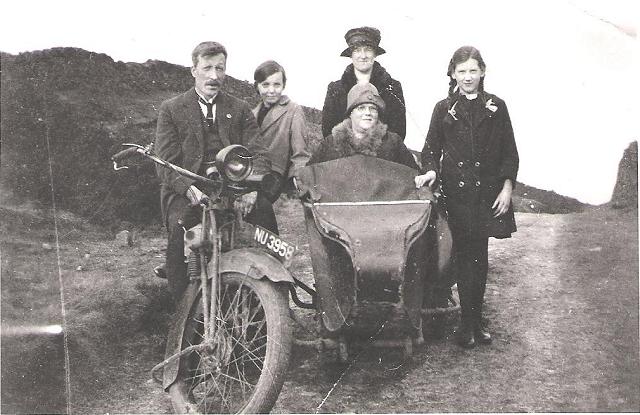
James Hill and his beloved motorbike NU 3958, 1920s. Daughter Ethel Hill on the pillion Edith Hill sitting in sidecar, Margaret Hill (sister-in-law) and Annie Hill (niece). Picture by Agnes Hulme.
My great-grandfather George Hill had moved his wife and two sons James and William from Whaley Bridge to Stockport in the 1890s to find work in coal mining trade, as the pits in their previous home of Whaley Bridge were closing. George worked at the colliery in Bredbury, and the 1901 Census finds the family living at 9 Portwood Hall Place, Stockport, on the road towards Bredbury. James Hill, their eldest son, was born in 1885 and is recorded on the 1911 census, aged 15, as a 'Colliery Labourer.' However, this did not last. James seems to have shown an aptitude for mechanical engineering - according to family legend he took to earning extra money by repairing bicycles - and appears to have served an apprenticeship with the firm of Hollingdrake in Stockport, an early entrant into the local motor-car market.

James married Edith Barratt in May 1906, and they had three children, all daughters, all born in Stockport: Alice (born November 1906) Agnes (1912) and Ethel (1915). The 1911 census form (above), completed by James in his characteristic clear handwriting, shows him as 'Iron Turner' for a 'Motor Engineer'. By this time he had a wife of four years and had a young daughter, all living with his parents and brother in the small house in Portwood Hall Place. Edith Barratt, a fellow Methodist, had worked in local cotton mills since the age of 12; the law at that time permitted work at that age provided it was part-time so school could be attended.
James's essential skills as an engineer saved him from the horrors of the World War I trenches, as engineers were needed at home for war work. It appears that he gained experience in the motor side of the business, as soon after his father died in 1916, he took up an offer to set up a motor engineering business, in partnership with John Scholes, landlord of the Hanging Gate Inn, and his son Fred. The 'Hanging Gate Garage' of 'Scholes, Hill and Scholes' was set in a building adjacent to the Inn, on the main road between Whaley Bridge and Chapel-en-le-Frith. He left Stockport and relocated with his three daughters and his widowed mother Alice to the nearby hamlet of Tunstead Milton. Their new home was a small cottage in a row adjacent to the Rose and Crown Inn.
James's daughter Agnes - my mother - had many stories to tell of her time in Tunstead Milton. She was expected to walk to Whaley Bridge Council School each day - a distance of two miles - with a penny in her pocket to be used to return by bus, but strictly only if it was raining or snowing! She also had to shepherd her sister Ethel, two younger girls, daughters of local farmer Mr Barnes and make sure they arrived at school. The school had opened in 1911, and still thrives as Whaley Bridge Primary School. (Many years later I attended the same school.) In my mother's day the head teacher was Mr Woolley, assisted by his daughter; reportedly he was as strict with her as he was with the pupils.
After a few years in Tunstead Milton, James had saved enough money to procure a bigger house for his family, and a plot of land was procured in Chapel Road, on which a detached house, named 'Merlewood', No. 87 Chapel Road, was constricted for £600 by a local builder, with some help from the Hill family; my mother recalled helping to prepare the ground for the foundations. The house was completed in 1927; it stands at the end of a track, parallel to and at a higher level that the Chapel Road, on which a couple of other houses had been constructed in those free-for-all days before the 1932 Town and Country Planning Act. It seems that the right-of-way over this track was not properly established, leading to a dispute in later years.
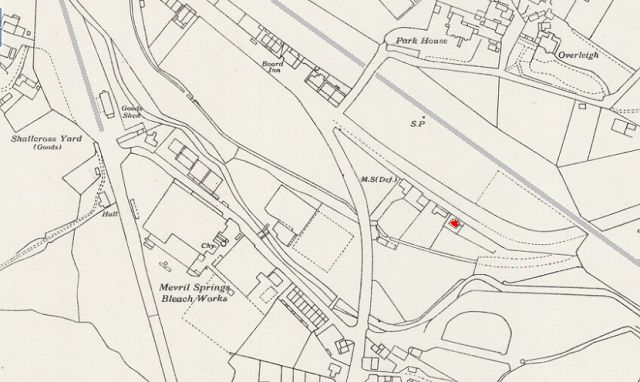
I have marked the house in red on the 1932 map. To the south-west, in the valley of the Randal Carr Brook, can be seen the terrace known as Shallcross Mill Cottages, where James had lived as a child, and the Mervril Springs Bleach Works where his daughters Alice and Agnes - and my own father - found employment.
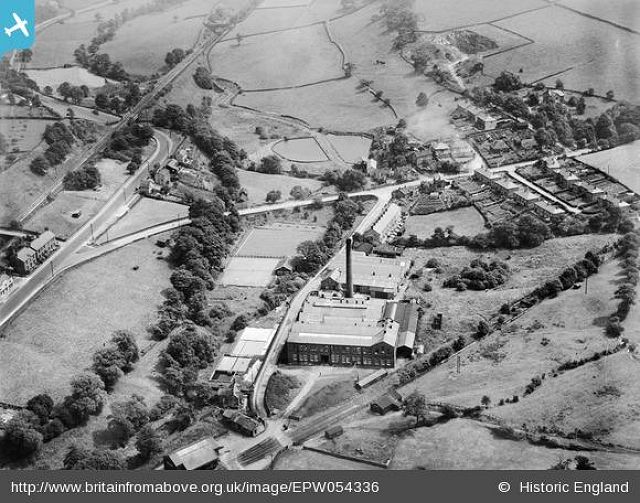
An aerial view from 1937: 'Merlewood' can be made out just before the road bends to pass under the railway. The Mevril Springs works is in the centre, with Elnor Lane running up to the right.
James's mother, my great-grandmother, Alice Hill moved with the family to the new house, and be proudly photographed there; she died in September 1929 aged 70. My grandmother Edith died in 1948, before I was born and later that year James married Winifred Smith, who was of the same age as, and a friend of, his eldest daughter Alice, which at the time would have led to a certain amount of disapproval from his peers. It also meant that his daughters would not be entitled to any inheritance.
The garage seems to have closed in the 1930s, and latterly James earned a living as a taxi driver based at Chinley where he would meet trains at the station. After all three daughters had left home, James (possibly with some input from 'Auntie Winnie') decided to retire, sell the house, buy a caravan and explore Britain by moving it between sites when they felt like it. So in 1953 they set off with the caravan behind their old car. How many sites they stayed at has not passed into family lore, but their final resting place, after the car proved unequal to the task, was Burgh Castle caravan park in Norfolk, where in the early 1960s we visited them and stayed in a nearby 'chalet' which I recall as being rather basic.
James Hill died in Norfolk in 1963; his widow Winifred returned to the High Peak and would visit us occasionally until her death in 1979. Like his parents, he was a devout Methodist - he and Edith were married at Brunswick Chapel, Portwood in May 1906, and after moving to Tunstead Milton they were stalwarts of Fernilee Methodist Chapel, James was a Lay Preacher. Strict rules were obeyed in the Hill household. No alcohol, no smoking, and playing cards was banned as they were 'instruments of the devil.' Dominoes was permitted however, and my mother retained her fondness for a game of 'fives and threes.' Sunday observance was strict, too - apparently my great-grandmother Alice refused to buy a newspaper on Monday because it must have been printed on Sunday. Edith and James are buried at Fernilee Chapel.
The three daughters
Alice Hill
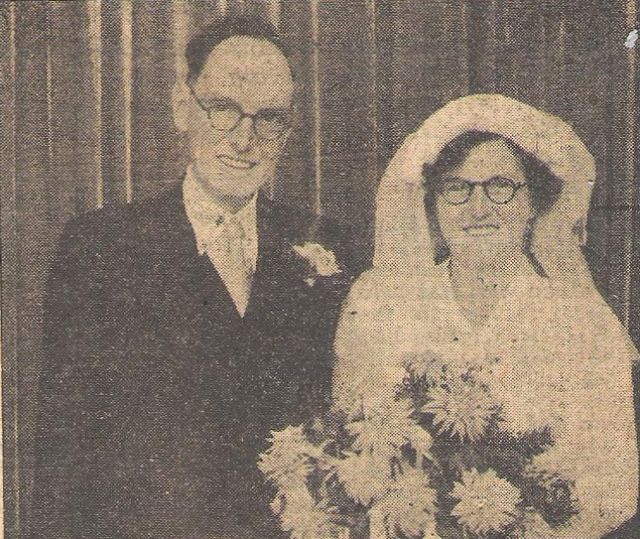
Alice Hill was born in Stockport in November 1906. When old enough to work, she became a domestic servant at 'Brookfield House' on Reservoir Road, Whaley Bridge, a large villa which had been built in the 1850s for the owners of the Bingswood Printworks. However, this career came to and end one day when her mother visited and discovered her polishing the silver on a Sunday, much against Methodist principles. She later found work at the Mevril Springs Bleach works, where women were employed in the packing department upstairs. In 1951 she married John Barton, a member of Windlehurst Chapel in High Lane; sadly she suffered from ill-health, including deafness, which caused trouble for people living above their rented ground floor flat in Parkside Close, High Lane who would complain about the noise from the TV. She was too old to have children, but both my cousin James and I remembered fondly the toys they kept to entertain us during visits. John Barton worked as a postman, but at some time he had also made a living by making toffee - the kind that comes in a tray to be broken with a special hammer, and extracts your fillings - and selling it on market stalls. Uncle John liked to take pictures; I especially recall his colour slides of Marple Carnival. His two sisters, Bessie and Florrie, seemed to be a great influence on his life. He died in 1975, and Alice in 1980.
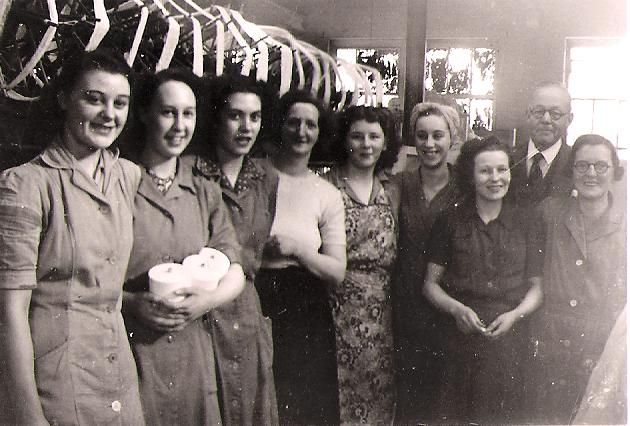
Ladies of the Mevril with the boss: Alice Hill on the right, 1930s.
Agnes Hill

My mother, Agnes, was born in Stockport in 1912, by which date, she told me, the family had moved from Portwood Hall Place to nearby Borron Street, although her Birth Certificate gives the address of 37 Hall Street which I never recall being mentioned. When she reached her teenage years seems to have been selected by her father as an assistant in his various activities, although he refused to allow her to learn to drive. He also refused her the chance to gain a 'scholarship' to continue her education at New Mills School, and she too found herself working at the Mevril Springs bleach works. Her duties involved wrapping parcels of bleached cotton, which had first been pressed to minimum volume by a man working a (hydraulic?) press.
After I was born, she became a home-worker for while, sewing pillow-cases for the Swan Vale company of Kettleshulme, and for three days per week was cleaner for Mr & Mrs Hindle of Cadster House. Later she ran the workers' canteen at the Goyt Mill weaving shed in Whaley Bridge for a number of years.
Her hobby from the 1920s onwards was photography with her Kodak Brownie, which means we do have a pictorial record of some of the people and events from that time. At the 'Mevril' after the War she met her future husband, Charles Hulme (Born in 1910), who was a labourer on the bleaching floor; a foul, heavy job in a damp building with chemical fumes about. He was actually a skilled craftsman, having worked in precision engineering during the War after being discharged from the Army on medical grounds, only to have his job given to a returning soldier. The works closed in the early 1960s; through the good offices of people who cared about us, father was found a new job at Bernard Wardle's print works a few miles away, which was cleaner, but involved carrying heavy rolls of cloth and sewing the ends together for use in the printing machinery. This he did for twelve hours a day from 8am to 8pm with a break for lunch and on Saturday mornings.
Agnes and Charles were married in Whaley Bridge Methodist Church in 1948, I was the following year, their only child. We lived at No. 12, and later next door at No. 11, Canal Street in Whaley Bridge (for more about me see my feature 'Me and Mrs Middleton') - which I eventually purchased. I left in 1985 when I married, while Agnes remained at No.11 until her death in 2002 aged 90, an age reached by few, if any, of her ancestors.
Charles, who wasn't very religious, smoked Woodbines and frequented pubs, was not James Hill's ideal choice for a son-in-law, but he seems to have come to terms with the situation. My parents, like many in that era, determined that I would not work as a labourer but would get a good education and a good job, which in those days was available with generous grants; they made sure I had plenty of reading material, and a Library Card on my fifth birthday, and had every chance possible. I think I have lived up to their expectations - it's perhaps not surprising that after gaining a degree in Engineering in 1971 I changed course, using my computer skills by working in a Library. The 1950s was the golden age of Holidays with Pay, and we always had two weeks' seaside holiday in July, 'wakes fortnight' for the Whaley Bridge textile mills. We had no car and always went by train, usually to a different place from the year before, sparking off my lifelong interest in railways.
Charles always suffered from illness, including severe depression, and died in 1966 when I was just 16. After I was born, Agnes left the Mevril, although she seems to have returned for a while later. She involved herself in the running of the Methodist Church, including the production of a booklet in 1957 to mark 150 years of Methodism in Whaley Bridge,which she compiled with the local chemist, Frank Livesley. Perhaps this started my interest in writing for publication. I have a clear memory of a visit with her to a printers' in Chapel-en-le-Frith delivering the 'blocks' for the pictures.
Once I was earning money, she gave up paid work and became the voluntary organiser of the Age Concern Day Centre in Whaley Bridge, and holidays by coach - often at Butlin's - for the attendees of the centre. She continued with the Day Centre until she was in her mid-80s.
Ethel Hill
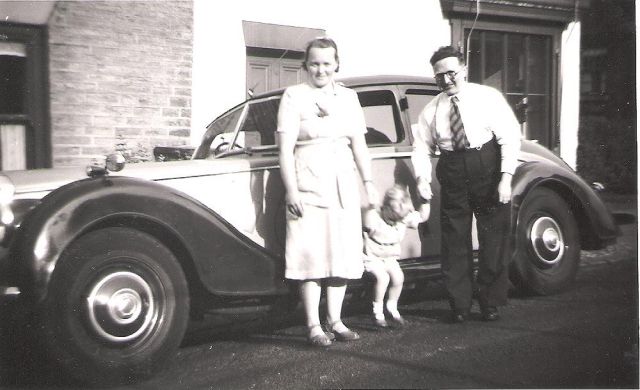
Ethel, William and James Edward Morris in Canal Street, c. 1949. Picture by Agnes Hulme
The first of the three daughters to leave home was the youngest, Ethel Hill (born 1915), who caught the attention of William Morris, who with his brother Eric was a partner in the nearby Shallcross Iron Foundry, which has been founded by their father in 1924. They married in 1936 and moved to a house on Manchester Road, Chapel-en-le-Frith, and later followed in James Hill's footsteps by having their own bungalow constructed in the triangular area seen on the map to the north-west of 'Merlewood'.
Ethel was a full-time housewife, but their early married life was fraught with unhappiness: she suffered a miscarriage, and then in 1938 gave birth to a son, John, who died in infancy. Not until after the War, in 1947, did they have another son James Edward Morris, the only relative of my own generation that I knew well as a playmate and friend. He married in 1969, and his four sons continue James Hill's lineage.
After a brief flirtation with a career on the railway, James Edward Morris re-entered further education and trained to become an IT support worker at Manchester University. He relocated to Leicestershire to advance his career at the University there, but his life was tragically cut short in 1992 following a road accident while cycling. He was interested in his family history, and this article relies heavily on a Hill family tree he compiled.
In the 1960s William Morris decided on a career change, sold his share in the foundry to his brother, and entered the do-it-yourself interior decorating business, very popular at the time. He opened a shop in Market Street, Marple, which flourished for a while and enabled us to obtain wallpaper at a discount. Ethel Morris, the youngest of the three sisters, was the first to pass away, in 1969, aged only 54. Her husband William suffered from Parkinson's Disease in the years before his death in 1979.
Written by Charlie Hulme, 2016. Comments welcome at charlie@davenportstation.org.uk